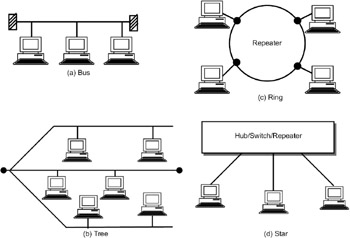17.3 LAN TOPOLOGIES
|
| < Day Day Up > |
|
17.3 LAN TOPOLOGIES
A LAN can operate in the following topologies: bus, tree, ring, and star, as shown in Figure 17.5.

Figure 17.5: LAN topologies.
Bus topology: In bus topology, the transmission medium has terminating resistance at both ends. Data transmitted from a node will flow in both directions. Terminating resistance absorbs the data, removing it from the bus when it reaches the end points. When a node has data to transmit, it broadcasts it over the medium, and all the other nodes receive it.
In baseband LANs, binary data is inserted on the cable directly, and the entire bandwidth is consumed by the signal. The signal propagates in both directions. Distance up to only a few meters is possible due to attenuation of the signal.
In an IEEE 802.3 LAN, 50-ohm cable of 0.4 inch diameter is used. Maximum cable length is 500 meters per segment. This standard is called 10 BASE 5 to indicate 10Mbps data rate, baseband, and 500 meter cable length.
For low-cost PC LANs (called cheapernet), 10 BASE 2 standard is followed.
The differences between 10 BASE 5 and 10 BASE 2 LANs are listed below.
| 10 BASE 5 | 10 BASE 2 | |
|---|---|---|
| Data rate | 10Mbps | 10Mbps |
| Maximum segment length | 500 meters | 185 meters |
| Network span | 2500 meters | 1000 meters |
| Nodes per segment | 100 | 30 |
| Node spacing | 2.5 meters | 0.5 meter |
| Cable diameter | 0.4 inch | 0.25 inch |
Tree topology: The tree topology is shown in Figure 17.5(b). The tree is a general form of bus, or the bus is a special case of tree. Data transmitted from a node is received by all the other nodes. There will be terminating resistances at each of the segments.
Ring topology: The ring topology is shown in Figure 17.5(c). In a ring topology, the medium is in the form of a ring with repeaters that connect to the nodes. In other words, repeaters are joined by the point-to-point links in a closed loop. A repeater receives the data from one link and transmits it on the other link. Each frame travels from the source through all other nodes back to the source where it is removed.
| Note | In ring topology, if the transmission medium fails (for instance, due to a cut in the cable), the network is down. To avoid such situations, dual-ring LANs are used in which two cables are used to connect the nodes. |
The repeater inserts data into the medium sequentially, bit by bit. Each repeater regenerates the data and retransmits each bit. The data packet contains the header with the destination address field. Packet removal is done either by the specified repeater or the source, after the ring is traversed.
The various LAN topologies are bus, tree, ring, and star. Choice of a particular topology is dependent on factors such as reliability, data rate, cost, and medium of transmission.
The repeater can be in one of the following three states:
Listen state: Scan the data for the address, for permission to retransmit; pass the data to the attached station.
Transmit state: Retransmit the data to the next repeater and modify a bit to indicate that the packet has been copied (serves as acknowledgement).
Bypass state: Data is sent without delay.
Baseband coaxial cable, twisted pair, or fiber can be used for repeater-to-repeater links.
To recover data from a repeater and to transmit data to the next repeater, precise timing is required. The timing is recovered from the data signals. Deviation of timing recovery is called timing jitter. Timing jitter places a limitation on the number of repeaters in a ring.
Ring topology has the following problems:
-
Failure of a repeater results in the breakdown of the network.
-
New repeater installation is cumbersome.
-
Timing jitter problems have to be solved (extra hardware is required).
Star topology: In star topology (Figure 17.5(d)), there will be a central hub to which all the nodes are connected. The central node can operate in broadcast mode or as a switch. In star networks, addition and deletion of nodes is very easy; however, if the central hub fails, the entire network is down. The hub acts as a repeater—data transmitted by a station is received by all stations. Hence logically, this topology is equivalent to a bus.
|
| < Day Day Up > |
|
EAN: 2147483647
Pages: 313